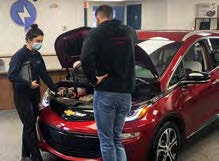In Praise of Everything EV
By Carter Hammett
Let’s start this column off with a piece of trivia shall we? The skill-testing question is:
When was Canada’s first electric vehicle built?
If you said 1893(!) you’d be correct.
As you can probably guess the concept came and went and then eventually disappeared as American designs dominated the landscape. Oddly, Canada, with its robust automotive sector, has no domestically-designed electric vehicle (EV).
With any luck that’s about to change, especially if Project Arrow can really fly.
The new arrow concept was created by a design team based out of Ottawa’s Carleton University in a national competition and is currently being whipped into shape in Windsor ON. The completed “virtual vehicle” is expected to debut later this year with a concept vehicle due in 2022.
The vehicle’s handle is inspired by the famous 1950s jet interceptor Avro Arrow, another Canadian milestone. That brought Canada to the edge of world leadership in aerospace technology but for reasons still unknown the plane got mired and politics and disappeared without a trace.
As of this writing, 93 Canadian suppliers and tech firms have signed on, but rumour has it that the project may never actually get off the ground. That’s because the idea was to demonstrate to investors that our fine country actually has the technology to produce an entirely new and original vehicle with all parts coming from Canada. The hope is to possibly inspire someone to become an OEM and build the vehicle on a commercial level.
Let’s hope this Arrow flies.
In January, Ontario’s auto sector received a huge boost after GM, Ford and Fiat Chrysler announced plans to invest as much as $1billion each in EV investments.
The announcements enthusiastically welcomed by Unifor, which represents over 20,000 autoworkers among the three companies. Not to be outdone, the provincial and federal governments are kicking in around $600 million in funding for the Ford plant.
In a country that produced close to 20 GHG per person in 2018—fifth in the world—where people are addicted to gasoline vampires, and it’s not unusual to drive hours to get to a weekend cottage, this is a country that’s ready for EVs.
To date, EVs only account for about three percent of all new vehicles sold in this country, and drivers still prefer big vehicles as witnessed by escalating sales even during the pandemic. And yet, and yet, the big three companies have goals to change that market penetration to at least 30 percent by the end of 2025. That’s good news, especially on the jobs front.
And next to finally…
Nova Scotians woke up to good news February 24 as the province announced it was incentivizing provincially registered drivers to turn electric with the aid of a new rebate program worth up to $3,000.
The rebate can be added to the $5,000 currently being offered by the feds, and applies to used vehicles as well. At present, only vehicles under $55,000 will qualify.
The program will divert about half of $19 million in funding to help make energy efficient upgrades more easily available to lower-income residents.
And finally finally….
In 2020 more than 54 per cent of all new vehicle purchases in Norway were electric, making the northern country the world champion in adopting all things electric. With consumer incentives that include everything from tax emptions to reductions on everything from licensing to free toll-road access, free charging and parking, Norway’s doing something right.
It’s something we can all aspire to.



Electric is the future, and you can drive the future today. Join the Atlantic EV conversation through the Electric Vehicle Association of Atlantic Canada : http://www.fbook.evaac.ca